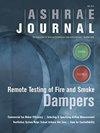Assessment of Airborne Disease Transmission Risk and Energy Impact of HVAC Mitigation Strategies
IF 0.8
4区 工程技术
Q4 Engineering
引用次数: 2
Abstract
The COVID-19 pandemic has focused renewed attention on the ways in which building HVAC systems may be operated to mitigate the risk of airborne disease transmission. The most common suggestion is to increase outdoor-air ventilation rates so as to dilute the concentrations of infectious aerosol particles indoors. Although this strategy does reduce the likelihood of disease spread, it is often much more costly than other strategies that provide equivalent particle removal or deactivation. To address this tradeoff and arrive at practical recommendations, we explain how different mitigation strategies can be expressed in terms of equivalent outdoor air (EOA) to provide a common basis for energy analysis. We then show the effects of each strategy on EOA delivery and energy cost in simulations of realistic buildings in a variety of climates. Key findings are that in-duct filtration is often the most efficient mitigation strategy, while significant risk reduction generally requires increasing total airflow to the system, either through adjusted HVAC setpoints or standalone disinfection devices.空气传播疾病风险评估及暖通空调减排策略的能源影响
2019冠状病毒病大流行使人们重新关注建筑暖通空调系统的运行方式,以减轻空气传播疾病的风险。最常见的建议是增加室外空气通风量,以稀释室内传染性气溶胶颗粒的浓度。虽然这种策略确实降低了疾病传播的可能性,但它往往比提供同等颗粒去除或失活的其他策略要昂贵得多。为了解决这一权衡并得出实际建议,我们解释了如何用等效室外空气(EOA)来表达不同的缓解策略,从而为能源分析提供一个共同的基础。然后,我们在各种气候条件下的真实建筑模拟中展示了每种策略对EOA交付和能源成本的影响。主要发现是,管道过滤通常是最有效的缓解策略,而显著降低风险通常需要增加系统的总气流,通过调整HVAC设定值或独立消毒设备。
本文章由计算机程序翻译,如有差异,请以英文原文为准。
求助全文
约1分钟内获得全文
求助全文
来源期刊

ASHRAE Journal
工程技术-工程:机械
CiteScore
1.00
自引率
12.50%
发文量
0
审稿时长
6-12 weeks
期刊介绍:
ASHRAE Journal publishes practical, application-oriented papers about HVAC&R technology that range from back-to-basics features to reviews of emerging technologies.
 求助内容:
求助内容: 应助结果提醒方式:
应助结果提醒方式:


